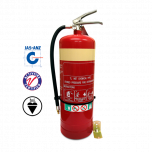 In Australia, Wet chemical Class F extinguishers were developed for modern, high efficiency deep fat fryers in commercial cooking operations. They may also be used on Class A fires in commercial kitchens. Here’s a guide on how to identify them, how they work and when to use them safely:
In Australia, Wet chemical Class F extinguishers were developed for modern, high efficiency deep fat fryers in commercial cooking operations. They may also be used on Class A fires in commercial kitchens. Here’s a guide on how to identify them, how they work and when to use them safely:
Wet chemical fire extinguisher colour:
All new fire extinguishers in Australia are painted with a rich red colour, which is referred to as Signal Red.
A Wet chemical extinguisher has a red body and will always have a OATMEAL colour band wrapped around the top of its cylinder.
Wet chemical fire extinguisher sizes:
Available in 2 portable Sizes: 2L & 7L.
How does a Wet chemical extinguisher work?
Each type of extinguisher works by attempting to remove one of the elements that are needed for a fire to flourish. Wet Chemical Extinguishers contain a solution of potassium, this solution smothers the fire and removes the element of heat. It prevents re-ignition by creating a barrier between the oxygen and fuel elements.
When to use a Wet Chemical extinguisher?
Wet Chemical extinguishers are mainly used on class F fires (cooking oils and fats) in commercial cooking operations. They also fight Class A fires (flammable solids such as rubber, wood, paper and textile materials).
Wet Chemical Extinguishers:
Class A Fires - rubber, wood, paper and textile materials etc
Class F Fires - cooking oils or fats etc

Wet Chemical extinguisher DO NOT USE ON:
Wet Chemical extinguishers should not be used on fires involving electrical equipment, flammable gases, and also are not suitable for use on flammable metals.
Where to use a Wet Chemical extinguisher?
Wet Chemical extinguishers can be used indoors and outdoors. Any facility that contains cooking oils, fats or deep fat fryers in commercial cooking operations, for example food warehouse’s, restaurants and so on.
How to use a Wet Chemical Fire Extinguisher?
Knowing how to operate a Wet Chemical fire extinguisher could save your life in an emergency.
The key to putting out a fire with a Wet Chemical extinguisher is to use the PASS strategy: Pull the pin, Aim the hose towards the base of the fire, Squeeze the lever, and Sweep the hose.
Remember: Fires double in size every 60 seconds so use a fire extinguisher for small, contained fires only. Leave immediately if you're unable to extinguish the fire and call 000.
Wet Chemical extinguisher Service & Maintenance:
In an Australian business environment, all Wet Chemical extinguishers must undergo a recharge and hydrostatic testing every 5 years. All Wet Chemical fire extinguishers must carry a maintenance tag that shows their last inspection date, and must be serviced every 6 months. Once your extinguisher has been discharged, it must be pressure tested & recharged, or replaced.
They should not be installed in locations directly exposed to extreme cold (possibility of freezing in conditions lower than -10°C).
At home, Wet Chemical extinguishers can last up to 10 years but you need to check them regularly (we recommend twice a year to check the following: pressure is at the recommended level, nozzle or hose are not obstructed, pin and tamper seal is intact, no dents, leaks, rust, chemical deposits and other signs of wear).
How to clean up after a Wet Chemical fire extinguisher?
- Protective gear - Wet Chemical is known to be irritating, it’s best to put on goggles and impermeable protective gloves before starting.
- Soak – soaking up the residue using paper towels or something disposable that can soak up the residue.
- Wash – Use water to wash the affected area until completely clean and continue to soak up any left over residue.
- Throw – Once clean, take the dirty towels and seal them in a plastic bag. You can then throw the contents away as you would any normal waste.
Wet Chemical fire extinguisher discharge effects to be aware of:
- Corrosion – alkaline is used in Wet Chemical fire extinguishers, it could corrode some metals, especially aluminum.
- Wet Chemical on your skin – rinse immediately with water, and consult medical attention if any symptoms persist.
- Prohibited disposal in drain systems – Wet Chemical extinguishers are not safe to discharge down normal drains;
How to Refill & Recharge a Wet Chemical fire extinguisher:
In Australia, Wet Chemical Fire extinguishers must be discharged and recharged every 5 years. The refill process should be done by a trained professional (handling of pressurized chemicals). If it is not done adequately, the extinguisher could malfunction in case of an emergency.
Here are simplified steps of the Wet Chemical refill process:
- Empty and depressurize the extinguisher (remove hose, valve assembly, clean...)
- Fill the cylinder with the amount of chemical specified on the label
- Re-Pressurize the extinguisher (check for leaks)
- Reconnect hose and ring pin
- Weigh the fully assembled fire extinguisher
Wet Chemical fire extinguisher Disposal & Recycling:
Wet Chemical Fire extinguishers are classified as a dangerous good and can not be disposed of at your household waste collection and/or curb-side collection. So how do you safely dispose of a used, expired but unused or empty carbon dioxide fire extinguisher?
Please check this article to dispose or recycle your old Wet Chemical Fire Extinguisher: https://www.fireextinguisheronline.com.au/fire-extinguisher-recycling
You can also contact your local fire department and enquire if you can drop those off at the firehouse to dispose of them (only for expired but full or partially filled fire extinguishers). And you can contact your local council.


